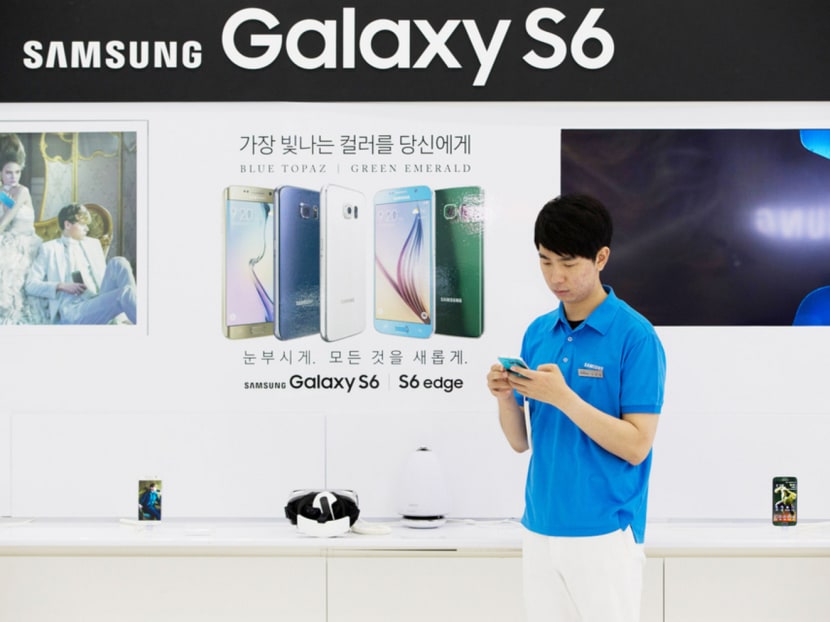Samsung’s Q2 profit falls as it fails to tap on S6
SEOUL — Though it has lately shown signs of a turnaround, South Korean tech giant Samsung Electronics yesterday guided for weaker-than-expected second-quarter earnings, as Galaxy S6 smartphones failed to lure enough customers away from Apple’s iPhones and cheaper devices made in China.

An employee with a Galaxy S6 Edge device at Samsung’s showroom in Seoul. Bloomberg
SEOUL — Though it has lately shown signs of a turnaround, South Korean tech giant Samsung Electronics yesterday guided for weaker-than-expected second-quarter earnings, as Galaxy S6 smartphones failed to lure enough customers away from Apple’s iPhones and cheaper devices made in China.
Operating profit for the second quarter probably fell 4 per cent from a year earlier to 6.9 trillion won (S$8.27 billion), Samsung said in a filing — its best profit in four quarters, but also the seventh straight period of annual decline. That compares with analysts’ estimates of 7.2 trillion won.
Sales totalled 48 trillion won, down 8 per cent from the 52.4 trillion won it posted a year earlier, it estimated.
Samsung did not provide details of net income or division earnings today. Audited results are scheduled for later this month.
Despite missing expectations, the predicted second-quarter results represent an improvement from the first quarter — an indication that one of the two engines powering Samsung’s growth, its semiconductor division, is performing well.
Still, the company’s huge chip and memory business failed to make up for the continued struggles of its once dominant mobile-phone unit.
Broadly, analysts said Samsung’s smartphone sales had suffered from slack demand because of weakening economies in Europe and China. In Europe, one of Samsung’s most profitable markets, the firm was also hurt as the euro lost value against the won, they added.
Still, there was plenty of blame for Samsung itself. Analysts said the company had failed to capitalise on its newest high-end handset — the Galaxy S6.
When introduced earlier this year, the S6 was popular, but sales were hurt when production constraints for the S6 model with a curved display led to shortages, trimming shipments of the device.
Mr CW Chung, an analyst at Nomura, said the production problems had most probably resulted in a reduction in sales of one million to two million handsets during the quarter.
He added that the production problems and strong competition from Apple were the primary reasons S6 sales had dropped to an estimated 18 million from the more than 21 million he had originally forecast.
While the company says it has fixed the problem, it may be too late to fully capitalise on a lull in competition for new high-end devices ahead of the launch of the latest Apple iPhones, expected to be as early as September.
At the same time, Samsung continues to face intense competition from low-cost smartphone makers coming from China and India. To compete, the tech giant has introduced a new, streamlined set of phones, known as the A series.
Initial results for the new line were positive. In the first quarter, the A series helped Samsung maintain its lead over Apple as the world’s largest vendor of smartphones by volume, based on a report by research firm IDC.
“Samsung’s shipments, given that the S6 was not launched in the market for the full quarter, were driven by large volumes in emerging markets and steady demand for its mid-range and lower-priced smartphones,” wrote Mr Anthony Scarsella, a manager with IDC’s mobile-phone team, in the report.
Samsung phones sold well in South-east Asia, the Middle East and Africa, added the report. However, as demand for new smartphones in China begins to moderate because of market saturation, Samsung has looked to other large markets such as India for growth.
Although the conditions in India are in some ways similar to China, with many local competitors and a price-conscious consumer base, Samsung maintains a big lead over Chinese smartphone makers.
Its international know-how and deep marketing experience may help it outmanoeuvre Chinese manufacturers as they try to sell outside their home markets for the first time.
Agencies





